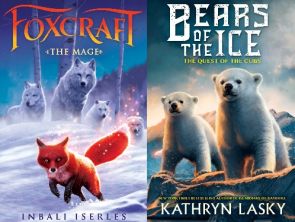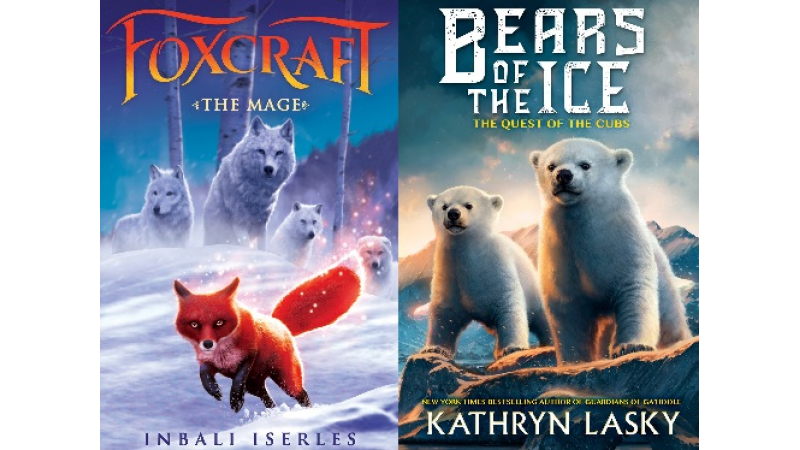 Today on OOM we're talking with Inbali Iserles, the author of The Mage (Foxcraft, Book 3) (ages 8–12), and with Kathryn Lasky, author of The Quest of the Cubs (Bears of the Ice #1) (on-sale 2/27; ages 8–12). Check out their conversation below!
Today on OOM we're talking with Inbali Iserles, the author of The Mage (Foxcraft, Book 3) (ages 8–12), and with Kathryn Lasky, author of The Quest of the Cubs (Bears of the Ice #1) (on-sale 2/27; ages 8–12). Check out their conversation below!
Hi to both of you! First off, how are you faring this particularly cold and blustery winter? Keeping warm, hopefully?
Inbali Iserles: Doing my best, thank you! I'm a summer person at heart. I have an intense impulse to hibernate every winter until the buds form on the trees. I adore snow, though, when it decides to visit us in the south of England. Even the bleakest, most ordinary sites become beautiful in the shimmering stillness of fresh snowfall.
Kathryn Lasky: I’m trying. As I was looking out the window of my study a few weeks ago, when we had at least two feet of snow in our garden, I kept telling myself that snow is actually insulating. Very good for spring bulbs I planted in the fall. So, there is the promise of color. I hope.
You both have recently published or soon-to-be-published books which take place in wintry settings. Inbali, your final book in the Foxcraft trilogy, The Mage, takes your young fox protagonist, Isla, to the frigid Snowlands. Kathryn, you’re beginning a brand new series, Bears of the Ice, with The Quest of the Cubs, which stars two polar bear twins, First and Second, as they try to rescue their mother. Tell us a little bit about your books, and the frozen worlds they explore.
II: At the outset of the Foxcraft series, urban fox cub Isla returns to her den to find it smouldering with embers and her family missing. Red-eyed foxes chase her into the night. She is determined to track down her family, but where to begin in the vast Graylands? Despite her youth and inexperience, Isla quickly discovers that the hazards of the city extend beyond the deadly reach of the furless (humans). She learns about foxcraft, magical gifts of cunning known only to foxes. According to legend, the crafts are overseen by mysterious Elder Foxes who protect its practice. Convinced that foxcraft will help her find her family, Isla embarks on a quest that takes her from the sprawling Graylands to the enchanted forests and fjords of the Wildlands, and ultimately to the Snowlands, the deadly lair of the snow wolves in the frozen north. Wildlands foxes are disappearing, red-eyed assassins stalk the night and a mysterious mage is intent on using foxcraft to sinister ends. As darkness gathers over the world of foxes, Isla is sure that the snow wolves can help. But these distant cousins have been sworn enemies for generations - and wolves are known to kill foxes for sport...
KL: This series opens with an ominous disaster. The two cubs’ mother has been seized and they’re left in the care of a vicious relative, Taaka. Their entire world has fallen apart. They’re determined to find their mother again. However unbeknownst to them, they are not the only ones threatened. The entire bear civilization is on the brink of being destroyed. This unlikely pair of heroes, First and Second, set out on a dangerous journey. At first, they think they are searching for their mother but it is truly more than just a search for a lost parent. It’s a quest to save the world of Ga’Hoole from complete annihilation.
Often animal fantasy mixes real animal survival tactics with more human social structures—and of course a touch of the supernatural! You’ve both come up with some imaginative ways that the creatures who inhabit cold climates survive. Tell us about the beasts who populate these inhospitable worlds, and your inspirations for their societies.
II: Foxcraft: The Mage is set in the frozen realms of the snow wolves. The Snowlands are brutal: blizzards rise over the tundra, rival wolf packs - known as “bishas” - stalk the edges of great forests, and months pass in darkness. There is constant pressure for resources. Wolves are the largest members of the dog family, apex predators that are many times greater than foxes, and yet even they must work hard to survive in such difficult terrain. What results is a sophisticated social structure. My inspiration for wolf society were warrior peoples, particularly those of the Arctic circle. In Foxcraft, the wolves of the north are bold, honorable and fearsome. They hunt the huge bison, an animal that could easily crush them. Only by working together can they isolate and defeat their quarry. The king and queen lead from the front, and are not supposed to fear death - to fall in pursuit of prey, or in battle, is a great honor. As a result, they must have total confidence in each other. Unlike the more independently-minded fox, or the dog who serves furless lords, the wolves strongly adhere to tradition. They howl to the spirit of their ancestors and consult their shaman, Amarog, before any hunt. While foxcraft is largely the magic of the individual, wolves find their power in the pack… Yet wolf society is not always fair. Just as there is a king at the top of the hierarchy, there is an under-wolf at the bottom - a creature so lowly that others scarcely deign to touch him. While some of these rigid practices may be important in the extreme environment of the Snowlands, they often seem strange or even cruel to Isla. A fox accepts no such hierarchy - a fox will not bow to a king.
KL: Well, the challenges of this arctic environment are great. And I found so much material that was simply fantastic—almost bordering on fantasy, but true. The biology of bears, arctic foxes, and seals is incredible. For example, polar bear fur is white but the skin beneath that fur is blue! It helps them retain heat. Their tongues are also blue. Unlike the wolves that Inbali talk about, polar bears do not hunt in packs. They are basically solitary creatures. A polar bear mother is the ultimate single mom. The cubs never meet or see their fathers and have to learn everything from their mothers. For me, this raised really interesting questions. Do these cubs ever have the dimmest idea that somewhere out there is a father whose blood they share? This opened up a lot of possible plot threads for my story. Another fascinating fact I learned is about arctic foxes. They have a brain that is very sensitive to magnetic fields. It’s like a tiny little compass in their heads.
What drew you to icy settings this time around? Do you have any favorite cold-weather stories that helped?
II: Despite being a summer person, I am fascinated by the far north. Iceland was a major inspiration for the Snowlands. While the Scandinavian country is often covered in a thick pelt of snow, geothermal activity below the surface explodes in bubbling geysers and sizzling streams - I included similar obstacles to Isla’s quest in The Mage. While wolves do not live in Iceland, they are still found in other parts of Scandinavia and Yellowstone National Park in the States. Indeed, Yellowstone also boasts geothermal activity and extraordinary geysers. I have had the great fortune of visiting northerly spruce forests in these magical locations. I fancied I could hear the faint echoes of wolf calls high in the icy foothills. I have not yet seen a wolf in the wild - but I’m working on it...
KL: To research this series, I actually went to Churchill in Manitoba, Canada and travelled out on the tundra to see the polar bears. Then we flew over Hudson Bay in a helicopter. Of course, the bears were magnificent and the sea ice was beautiful. But for me, the most significant part of our trip was the vastness of this land. It was both beautiful and frightening. Twilight lingers for hours that far north. There is a serenity to the horizon-less expanse visible from the helicopter. I spotted a polar bear curled up sleeping peacefully in an ice ‘bed’, and later a mother and two yearling cubs tumbling in a snow bank. For the bears this was home. This was cozy. This was nourishing and safe. I was fortunate to have a glimpse into their world.






